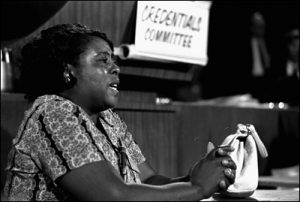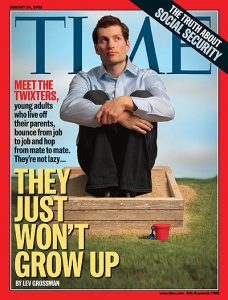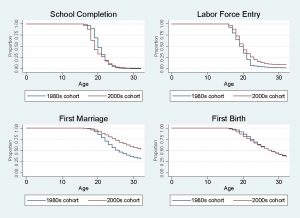As part of our On The Market series, our newly-minted Dr. Amina Zarrugh shares some sage advice on how to maximize Employment Services, one of several resources that the American Sociological Association provides graduate student members.

Each year during the ASA annual meeting, the organization facilitates meetings between prospective job candidates and employers. These meetings, referred to as “Employment Services,” are brief 20 minute meetings that are sometimes regarded as preliminary interviews for the upcoming job market. This is a paid service (roughly $50-55), which you must purchase in advance of the conference (through your ASA account) if you would like to access information about employers as early as possible. The process can be unclear unless you have already been through it once before so here is a brief “how to” to help those who may be navigating it for the first time.
Purpose
The purpose of ASA Employment Services is for job candidates to meet faculty from universities that intend to hire new faculty for the upcoming year. It is important to recognize that not all universities that plan to hire in the fall will hold meetings during ASA and not all of the meetings are considered by universities to be part of their formal interview process. Universities approach ASA Employment Services with different intentions and purposes; for some, the ASA interview is an opportunity to sincerely assess candidates and expedite their job search while for others the ASA interview is an opportunity for them to share information about their universities and positions. As a candidate, you should be prepared to treat each interview as an opportunity to both 1) practice describing your dissertation and your broader research plans and teaching style and 2) learn more about schools to which you may apply. The interview process can be an important exercise in learning how to talk about your research and can also provide you with important details about schools that you can later include in your application materials. Use this opportunity to think about how your application can benefit from speaking to members of the search committee.
Process
The process of participating in ASA Employment Services is composed of two phases:
Before ASA
After registering and paying for ASA Employment Services, you will be granted access to an interface which will allow you to post your CV, fill out a calendar with your availability, and see employer postings. Universities that are hiring in the coming academic year and who would like to meet with candidates at ASA provide information about the position(s), application materials, and contact information. Most job postings will not appear until late July or early to mid-August. Several postings may appear during the ASA annual meeting itself so you should continue to check for new postings while you are at ASA.
First and foremost, you should post a CV and fill out the calendar with your availability. You should be as generous as possible regarding your availability on the calendar; leave open many time slots (twenty-minute increments) so that universities will have several choices from which to select when scheduling a meeting with you. It is especially important to keep Saturday and Sunday as open as possible because many faculty will only be at the conference during the weekend given that some universities commence classes before the conference concludes.
Secondly, and perhaps most importantly, you should contact employers through the ASA Employment Services interface before ASA. Contrary to the idea that employers will contact you because you posted a CV, you need to contact employers as soon as possible. There are far more job candidates than employers and, therefore, it is incumbent upon you to take the initiative and invite yourself to be considered for an interview. It is possible that you will receive a request to meet from universities on the basis of your CV but it is less common.
Once your CV is posted and you have filled out your availability, you should begin writing employers as soon as they have posted a job ad. It is important to note that they may not reply to your invitation until two to three weeks before the conference in order to process all of their interview requests; however, it is good to express your interest early.
Your message should be framed as an “expression of interest” in a position. In your message, be sure to include the following:
- Your name, university, and expected graduation date
- Your research interests (in order of importance according to the job ad) and a one-sentence description of your dissertation
- Any sources of funding that you have received in support of your work (see example for how to assert this in a modest way)
- Your broader research agenda (especially if you can connect it to other aspects/requirements of the job description)
- Your teaching philosophy (brief statement that connects to research, if possible)
Here’s a sample message:
Dear Dr./Professor [CONTACT LISTED IN ASA EMPLOYMENT SERVICES],
I am writing to express interest in the position of [POSITION] in the [DEPARTMENT] and at [UNIVERSITY].
I am a PhD candidate in the Department of Sociology at the University of Texas at Austin and I plan to graduate in [MONTH, YEAR]. I specialize in [RESEARCH INTERESTS PRIORITIZED BASED ON JOB AD]. With funding from [FUNDING SOURCE], I examine [ONE SENTENCE DESCRIPTION OF YOUR DISSERTATION]. My broader research agenda also includes a focus on [ONE SENTENCE ABOUT YOUR OTHER RESEARCH].
With my international research experience [FIND A WAY TO BRIDGE RESEARCH AND TEACHING], I bring unique insights to the classroom through a global perspective on classic sociological topics. I am firmly committed to teaching, which is evidenced by [INCLUDE ANY SPECIAL TRAINING OR EXPERIENCES YOU HAVE RELATED TO TEACHING]
I thank you in advance for your time and consideration and I look forward to an opportunity to meet with you at the ASA annual conference.
Best,
[NAME]
In response to these messages, you will receive requests from employers who suggest a specific day and time to meet on the basis of your calendar of availability. You will receive requests through ASA Employment Services and copies will also be sent to you via e-mail. You will use the ASA Employment Services interface to confirm the requests. If you are invited to an interview, you should confirm the request and also send a message thanking the employer for their time and stating that you are looking forward to the meeting.
During ASA
Before ASA begins, you should have confirmed the universities and faculty with whom you will be meeting (though some universities will provide later notice and will contact you during the conference, so keep looking at your ASA Employment Services interface).
For each department, you should closely research its programs, research areas, and its curriculum and classes. It is very important that you pay close attention to the research program and classes taught in the department because many of the questions you will be asked throughout the interview will concern how you relate to these aspects of the department. You can access this information on most departmental websites and you should prepare before ASA so that you can review it on your way to ASA and during breaks you may have during the conference.
Upon arriving to the annual meeting, you should locate the registration area of the conference, where you will confirm your participation in ASA Employment Services on-site. You will be provided with instructions about how the process works and you will be given a name tag that permits you access to the Employment Services area.
The meetings take place in a common and open, but secure, space with several tables (akin to the structure of a roundtable session). To each table is affixed a number that is assigned to a specific university. You should plan to arrive early to your scheduled interview meeting in order to look up the table number that corresponds to the university with which you plan to meet. The meetings are twenty minutes long and an orchestral sound will signal that two minutes remain in the interviews. The end of meetings is punctuated with another orchestral sound, which signals people to end their meetings and new meetings to begin. Bring a copy of your CV with you and, if you have them, business cards to give to the employers; some employers will have a copy of your CV while others may not.
You will be meeting with as few as one departmental member and as many as three members; many meetings take place with two departmental members, which helps facilitate the conversation. This means also that you will need to make sure that you speak to (and make eye-contact with) both departmental members during the conversation. Meeting with multiple faculty members underlines the importance of researching the universities beforehand and being aware of who belongs to the department.
Potential Interview Questions
While twenty minutes is not a long time, it is possible to cover several topics, which generally focus on your dissertation, research, and teaching. Most faculty will leave at least five minutes towards the end of the meeting for you to ask questions about their program and department so you must have 2-3 questions prepared to ask of each university (and these can overlap).
- Research: The questions that relate to your research will concern your dissertation, your future research plans, and how your interests connect to the job. You should be prepared to briefly summarize your dissertation punchline and its contribution. Be prepared to talk about the key arguments in any papers you have published or are under review. Examples of questions:
Dissertation
- Could you tell us about your dissertation?
- When do you plan to defend?
- What have you written and what remains to be written? (Be specific about the chapters you have completed and offer a concrete schedule for when you plan to complete remaining chapters)
Research Interests
- Tell us about your research interests.
- Where do you see your research going in the future?
- How did you become interested in this line of research?
Papers
- Tell us about this paper (describe key argument and how it connects to your broader research agenda)
- Tell us about your collaborations (be prepared to discuss your contributions to papers that have multiple authors).
- Teaching: The questions that relate to your teaching will concern what types of teaching you have done, how you approach teaching on a pedagogical level, and what kinds of classes you would like to teach and how you would approach them. Your research about individual universities will help you identify what classes you could contribute to each university (and you should identify courses that you are capable of teaching and would contribute to the program).
Teaching Background
- What classes have you taught?
- How did you teach these classes? (Evaluations, assignments, etc.)
Approach to Teaching
- What is your philosophy about teaching?
- How would you approach teaching “x” course? (Some faculty will ask you about how you would teach specific courses so pay close attention to job ads and whether they mention classes that future faculty are expected to teach)
Future Classes
- What classes would you like to teach? How would you teach them?
- Your Questions: While ASA Employment Services is an opportunity for employers to get to know you, it is also a chance for you to learn more about specific universities. You should anticipate the opportunity to ask questions of the employers and you should prepare questions for each university. Some topics/questions include:
Research-related Questions
- Are there any departmental area groups? Are there faculty writing groups?
- What kinds of support exist for research travel and conference travel?
- Does the department plan to develop a particular research area in the future?
- What kinds of affiliated research centers exist at the university?
Teaching-related Questions
- What is the teaching load and how many new course preparations are expected?
- Will I be able to teach courses in my field or will I be expected to teach introductory and methods courses?
- Are there opportunities to co-teach classes?
- How many sociology undergraduates (and/or graduate students) are there and what are the expectations regarding advising?
University- and/or City-related Questions
- What kinds of institutes and centers exist for collaboration between departments?
- What roles do the university and department play in the community?
After your interview, you should take notes about the discussions you had with committee members, particularly if they communicated information that could be useful to your preparation of an application.
When the annual meeting concludes, you should send thank you notes to the faculty members with whom you met to express appreciation for their time and the information they shared about their department and university. This is an opportunity to underline your interest in the program and to state your intention to submit an application.
See more on Employment Services here. You can also reach out to Amina for more amazing advice!
Amina Zarrugh received her Ph.D. from the Department of Sociology in 2016. She joins the faculty at Texas Christian University as an Assistant Professor. Her research interests focus on gender, nationalism, and religion in North Africa and the Middle East from a postcolonial perspective. Her dissertation examines regime violence in Libya and the mobilization of women in a family movement that developed in response to a contested prison massacre at Abu Salim Prison in Tripoli.








